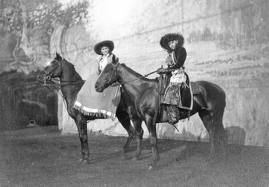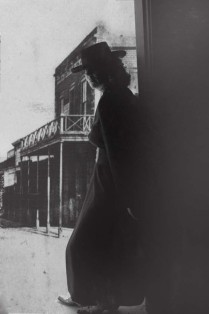After acting as either a cowboy or a soldier in nearly one hundred films, John Wayne finally won a best actor Oscar in 1969 for True Grit. The quintessential macho man was himself exempt from service during World War II owing to a problem with his shoulder. Winning the Oscar, some say, added another ten years to his life. Although he was a longtime smoker, averaging four packs a day, Wayne nevertheless died of gastric cancer at age seventy-two in 1979. In 1955 John Wayne was among two hundred twenty cast and crew member who worked on the film The Conqueror. It was shot on a location in Utah, which was contaminated by radioactive fallout from atomic bomb tests. Much of the soil was transported back to Hollywood for studio scenes. By 1980 more than ninety of those who worked on the movie contracted cancer; forty-six died. Even though Wayne knew of the danger, often carrying a Geiger counter onto the set, he believed the risk insignificant. For more information about the great John Wayne read The Young Duke: The Early Life of John Wayne by Howard Kazanjian and Chris Enss. 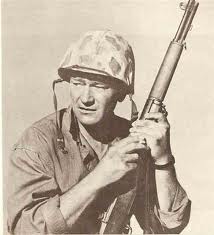
Journal Notes
Senorita Rosalie
Senorita Rosalie was the Mexican star of the Wild West Show. She was a stunning, black-haired woman who had achieved fame as a trick rider. She would jump over walls and ride holding the reins in her mouth while standing on the back of her horse. With her feet firmly placed on the ground, she would spur her horse on and jump on its back. While the animal was in full gallop, she would fling her body in and out of the saddle and dangle precariously off the sides of the horse. She could even lie down in the saddle and retrieve items left on the arena floor. Senorita Rosalie’s expertise on a horse made her a highly sought after riding instructor. Many Wild West performers benefited from her horseback-riding advice.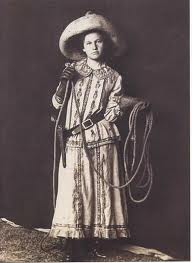
The Parry Twins
Ethyle and Juanita Parry
The famous cowgirl twins were a major attraction to Bill Cody’s program in the early 1900s. The twins were called Cossack Girls because they performed all the reckless and daring feats of horsemanship attributed to the Russian Cossack cavalry men. The twins were adept at riding wild broncos and were exceptional ropers. Newspaper reviews hailing the ladies’ performance at a show in Minnesota noted that not only could the Parrys ride well but “they were pretty and attractive, and nice to look at on or off a horse.”
Fannie Sperry
Fannie Sperry came into this world on March 27, 1887. She was born and raised on a horse ranch in the Beartooth Mountains of Montana. She parlayed her natural easy way with horses into a lucrative career riding in rodeos and performing in various Wild West shows including Buffalo Bill Cody’s. Fannie’s parents helped mold her into a fine equestrian. They taught her how to transform horses into first-rate cowponies. She used her skill for breaking horses in her act with Cody’s Wild West Show. When Fannie joined the program in 1916, she had a number of roping and riding titles to her credit. The Women’s Bucking Horse Championship of Montana and the Lady Bucking Horse Champion of the World were two of the most prestigious. She died of natural causes on February 11, 1983 at the age of ninety-five.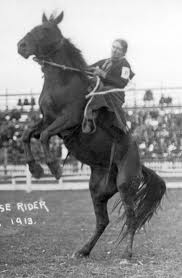
The Sure Shot
Annie Oakley was born Annie Moses on August 13, 1860, in Drake County, Ohio. Her father’s untimely death when she was still a child forced Annie to find work to help support her seven brothers and sisters and their mother. Annie first learned to hunt with a rifle when she was eight. She used her natural markswoman ability to provide food for the evening meals. She became such a good shot that she was hired on by a merchant to supply his store with fresh game. A shooting match between Annie and Western showman Frank Butler in 1875 changed her life forever. The challenge was for each marksman to shoot twenty-five clay pigeons. Frank hit twenty-four of the twenty-five targets. Annie hit all of them. Buffalo Bill Cody hired Annie to join his Wild West cast in 1885. Annie packed the house nightly with her trick riding and trick shooting. Cody called Annie “the single greatest asset the Wild West ever had.” 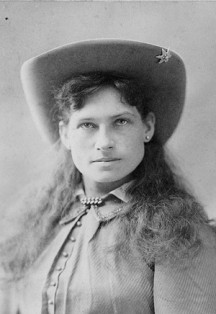 Annie and her husband Frank enjoyed seventeen seasons with Buffalo Bill’s Wild West Show. She retired from the program in 1902 and died of pernicious anemia in 1926 at the age of sixty-six years old.
Annie and her husband Frank enjoyed seventeen seasons with Buffalo Bill’s Wild West Show. She retired from the program in 1902 and died of pernicious anemia in 1926 at the age of sixty-six years old.
The California Girl
Lillian Smith was born on February 3, 1871, in Coleville, California. Her first performance with the Wild West Show was in St. Louis in the later part of 1886. Her proficiency with the rifle left such a lasting impression on the audiences that within six months she had earned a spot on the regular show lineup. Lillian’s remarkable target-shooting act kept audiences on the edge of their seats. Each performance ended with her firing at a glass ball that was tossed into the air. She would purposely miss it three out of four times. The bullet from the last shot would shatter the ball into pieces. It was that display of skill that prompted U.S. and European newspapers to proclaim her to act to be “spellbinding and captivating.” Lillian Smith, who was billed as the California Girl, left Buffalo Bill’s Wild West Show in 1889 and formed her own short-lived western program. Lillian retired from performing in the mid-1920s and lived out the rest of her days in a cabin along the banks of the Salt Fork River in Oklahoma.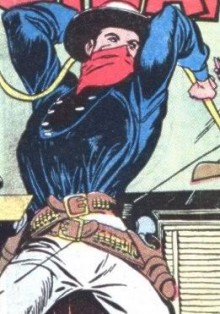
The Oriental Saloon
Tombstone, in the Arizona Territory was notorious as the meanest mining town in the western frontiers, and Tombstone’s Oriental Saloon was similarly renowned. As many as 200 men may have been shot to death there in pointless even idiotic arguments that originated in the Oriental. On one occasion, John Ringo invited Louis Hancock to have a drink with him. When Hancock agreed and asked for a beer, Ringo said, “No man drinks beer with me. I don’t like beer.” Ringo finally shot Hancock who allegedly was buried with a bottle of beer. The original Oriental was started by Jim Vizina in a canvas tent with two wagon loads of whisky. It later moved to an actual building that was lavishly decorated by the new owner, Mike Joyce. Joyce later sold out to Lou Rickabaugh, who gave a quarter interest to Wyatt Earp for protection purposes. Gunmen Bat Masterson and Luke Short ran the gambling tables, with Earp and his friend Doc Holliday often present. Earp and Doc Holliday left town following the gunfight at the O.K. Corral. Tombstone’s silver mine died out, and the Oriental folded with it.
The Horse Thief
Dutch Henry aka Henry Bourne, was an outlaw who died in 1930. Henry Borne, a German immigrant called Dutch Henry, became known for horse thievery. After arriving in the U.S. he joined the Seventh Cavalry, but quit in the late 1860s. Shortly afterward, Borne was arrested at Fort Smith, Arkansas, for absconding with twenty government mules. He was sentenced to prison, but escaped just three months later and became a full-time horse thief, an avocation he pursued until the automobile replaced the horse. Dutch Henry sometimes had over 300 men on his payroll who were prepared to steal any herd, no matter how large. It was said that the crafty Dutchman once sold a sheriff his own recently stolen horse, and “Dutch Henry” came to mean a stolen horse. In 1878, Bat Masterson arrested Henry, but he escaped punishment. The state of Arkansas finally succeeded in putting Dutch Henry away after they connected him with the Fort Smith robbery years earlier. He spent the next twenty years behind bars, and emerged from prison to discover that there was no longer a market for horse thieves. Hollywood borrowed his legendary name for many scripts featuring western badmen.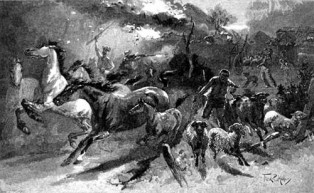
The Infamous Belle Starr
Myra Belle Shirley, better known as Belle Starr was born in Carthage, Missouri, the notorious Belle Starr moved with her family at the age of sixteen to Scyene, Texas, just outside of Dallas. In the 1860s, Starr became involved with bank robber Cole Younger, Jesse James’ partner. The couple spent several months together in a small cabin on the Oklahoma Strip with Younger was hiding out from the law after robbing several banks. After Younger rejoined the James Gang, Starr gave birth to a daughter, Pearl, who was though to be Younger’s child. Starr’s next romance was with another bank robber, Jim Reed. Along with Reed and two other criminals in 1869, Starr robbed a California prospector suspected of having hit a rich vein. The four tortured the prospector until he told them where his gold was hidden, and they got away with $30,000. After Reed was shot in a gun fight in 1874, Starr and an Indian outlaw named Blue Duck organized a horse-and-cattle-rustling ring. Starr then married a Cherokee Indian named Sam Starr were arrested in 1883 and sentenced to six months in jail. After their release, they returned to rustling and were arrested again in 1886. Although they appeared before ‘hanging’ Judge Isaac Parker at Fort Smith, they were released for lack of evidence. Sam Starr was shot and killed in a barroom brawl in December 1886. Starr’s last lover was a Creek Indian named Jim July. On February 3, 1889, after riding part of the way to Fort Smith with July, Starr turned back to her home in Younger’s Bend. A gunman apparently lying in wait shot her off her horse. She was found by a passing traveler who took her home to her daughter. When she died. Pearl had her tombstone engraved with the following inscription: “Shed not for her the bitter tear, Nor give the heart to vain regret, ’Tis but the casket that lies here, The gem that fills it sparkles yet.” 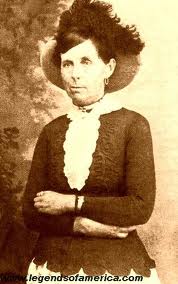
Holliday the Dentist
J.H. Holliday, Dentist, very respectfully offers his professional services to the citizens of Dodge City and surrounding country during the summer. Office at room No. 24, Dodge House. Where satisfaction is not given money will be refunded.
Denizens of Dodge whose ‘miscreant molars’ gave trouble were able to be ‘drilled’ by Doc without suffering from lead poison. One wonders if there were any dissatisfied customers with nerve enough to complain.

